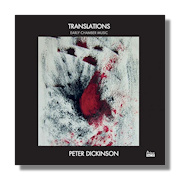
The Internet's Premier Classical Music Source
Related Links
- Dickinson Reviews
- Latest Reviews
- More Reviews
-
By Composer
-
Collections
DVD & Blu-ray
Books
Concert Reviews
Articles/Interviews
Software
Audio
Search Amazon
Recommended Links
Site News
 CD Review
CD Review
Peter Dickinson

Early Chamber Works
- Sonatina for Recorder & Piano (1956)
- Lullaby for Clarinet & Piano (1967/1982)
- Translations for Recorder, Gamba & Harpsichord (1971)
- Threnody for Cello & Piano (1956)
- Four Duos for Flute & Cello (1962)
- Fantasy for Clarinet & Piano (1956)
- Sonatina for Solo Bassoon (1966)
- Waltz for Elliott Schwartz for Piano (2016)
- Freda's Blues for Piano (2016)
- Lullaby from "The Unicorns" for Piano (1967/2016)
Peter Dickinson, piano
Joseph Havlat, piano
Peter Lawson, piano
Rosie Burton, bassoon
Lydia Hellerrudh, cello
Stuart Eminson, clarinet
Rosannna Ter-Berg, flute
Peter Lawson, piano
Richard Tunnicliffe, gamba
Harvey Davies, harpsichord
John Turner, recorders
Recorded in 2017 at the Royal Northern College of Music, Manchester
Prima Facie PFNSCD009 2018 60:58
As the dates make clear, a few of these pieces are actually recent; the others were early indeed, when the composer was in his early twenties, and a Cambridge undergraduate. I shall resist the pop term which comes to mind but, although old, these pieces are good, and worth hearing. In fact some of them – notably the Threnody – are among Dickinson's most appealing works. The three final piano works are exquisite.
The sonority of most of these pieces is refreshing, typically for single woodwind with piano. No oboe (my favorite wind instrument). The bassoon piece, inspired by frequently overheard practice sessions, sounds much like improvisation, so is less interesting than the other pieces. The only trio – and much the longest piece, with five movements, is the album-title work "Translations," a baroque combination of recorder, gamba and harpsichord, commissioned by the important early music specialists David Munroe, Christopher Hogwood and Oliver Brooks. It sounds nothing like Pleasures of the court, however! Sonorities are high pitched and it includes a "mad cadenza" and a "sort of jazz fugue." The forms of the other works are varied: sonatina, fantasy, lullaby, waltz, blues.
Dynamics are moderate; there are no outbursts. I already mentioned Threnody. That title suggests a memorial sometimes for an individual; no one is named in connection with this one, but it is dedicated to Penelope Lynex, who gave its first and many subsequent performances. Its mood is pensive, perhaps mournful, but not a cri de coeur, such as the Threnody for the Victims of Hiroshima. Nor does it affect me like the Chopin Marche funebre I once heard played by Khatia Buniatishvili from the front row of the Salle Pleyel, which actually moved me to tears remembering all the people I've lost. This Threnody is a lovely, mostly gentle work.
Strongly recommended.
Copyright © 2018, R. James Tobin


















